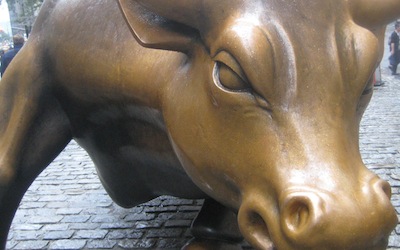Morgan Stanley and Bank of America Corp.’s bets on the brokerage business are finally paying off, helped by U.S. stock indexes near all-time highs. The firms’ own shares aren’t getting the same benefit.
Morgan Stanley fell 5.4 percent to $20.31 yesterday after saying profit from global wealth management jumped 33 percent to $376 million in the first quarter. Shares of Charlotte, North Carolina-based Bank of America slid 6.8 percent since the company reported April 17 that income from Merrill Lynch and related units climbed 31 percent to a record $720 million.

“As a shareholder, you can’t be rewarded for a part of the organization doing well if it’s lost in the mix,” said Joshua Siegel, founder of New York-based StoneCastle Partners LLC, which invests in community banks and has $5.7 billion in assets under management. “Investors are saying, let’s look at the rest of the businesses, and the problem is they’re dull.”
Banks are betting more on the old-fashioned business of investing for the rich after their strategy of making markets in stocks, bonds and derivatives turned out to be riskier than predicted. The higher profits at the two brokerages, the world’s largest, are being overshadowed by a slowdown in institutional trading and firm-wide drops in revenue at Morgan Stanley and Bank of America.
Morgan Stanley Chief Executive Officer James Gorman, 54, invested in the brokerage in 2009, creating and taking control of a joint venture with Citigroup Inc.’s Smith Barney. Former Bank of America CEO Kenneth D. Lewis struck a deal to buy Merrill Lynch and its “Thundering Herd” of brokers in 2008 after Lehman Brothers Holdings Inc. collapsed.
Bond Trading
Net revenue for Morgan Stanley’s brokerage, run by Greg Fleming, rose to $3.47 billion in the first quarter, 41 percent of the company’s total. The firm also said yesterday that bond- trading revenue dropped 42 percent from a year earlier and stock-trading revenue fell 19 percent, offsetting the gain.
Bank of America posted a net loss in consumer real estate and set aside more money to cover defective mortgages from the financial crisis. Meanwhile, revenue from its wealth division rose 6.6 percent to $4.42 billion, or 19 percent of the bank’s total revenue.
“Their results have been improving the last couple quarters,” said Shannon Stemm, an analyst with Edward Jones & Co. in St. Louis. “There are just other issues going on that are overshadowing the strength that we’ve seen from wealth- management units.”
Beating Estimates
Shares of JPMorgan Chase & Co., Wells Fargo & Co. and Goldman Sachs Group Inc., along with Bank of America and Morgan Stanley, have dropped since the companies posted first-quarter results, even as four of them reported profits that beat analysts’ estimates. With combined adjusted revenue down 2.5 percent, the firms relied on a mix of tax benefits, job cuts and lower expenses from bad debts and litigation to fuel profit.
Bank of America and Morgan Stanley trade below tangible book value, a measure of what a company would be worth if liquidated. Smaller financial-services firms with brokerages fare better: Raymond James Financial Inc. trades for 2.02 times tangible book, while Stifel Financial Corp. is at 1.65.
Christine Jockle, a spokeswoman for New York-based Morgan Stanley, and Bank of America’s Susan McCabe declined to comment.
Morgan Stanley’s bet on the brokerage model may have soothed creditors as the extra yield investors demand to own the bank’s bonds instead of Treasuries fell by more than half in the past year.
Government Debt
Low yields on government debt spurred investors to put their money at risk, fueling gains in equities and the fees brokers charge as a percentage of assets they manage. The Standard & Poor’s 500 Index surged 10 percent in the first quarter and hit a record 1593.4 on April 11. In 2007, when the benchmark touched its previous high, Merrill Lynch’s wealth management pretax earnings jumped 59 percent.
“A rising market definitely helps the wealth-management space at any company,” said Tom Pacilio, who left Morgan Stanley in 2011 to found Pacilio Wealth Management in Westport, Connecticut, which oversees about $200 million. “People are more inclined to start investing or shifting some of their investments.”
When Morgan Stanley agreed last year to buy the rest of its joint venture from New York-based Citigroup, the two banks agreed to value the entire unit at $13.5 billion after hiring an outside appraiser to settle a protracted dispute. Morgan Stanley is waiting on regulatory approval to complete the purchase of the 35 percent it doesn’t yet own.
Financial Crisis
Gorman’s gambit may gain in value as investors return to the markets after being burned by a drop of almost 40 percent in the S&P 500 in 2008 and a financial crisis that spurred consolidation in the industry.
“We went through some very difficult times where client trust and risk tolerance was eroded, and now we’re seeing a normalization of how the market is perceived,” said Dick Risch, founder of New York-based Risch Group, a search firm specializing in private banking and wealth management.
Morgan Stanley had the highest inflows into its fee-based accounts in two years during the first quarter. That helped the unit post its highest pretax margin since the joint venture was formed. Merrill Lynch’s revenue per financial adviser jumped 9 percent from a year earlier.
“It takes time to convince everybody of what you were and what you’re becoming,” said Marty Mosby, an analyst at Guggenheim Securities LLC in Memphis, Tennessee. “We’re just not there yet.”




